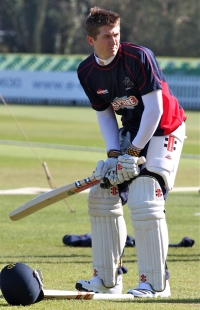|
 Grit. Grit.
Could those 4 letters be the most powerful weapon in becoming a successful cricketer?
There is strong evidence that it's a vital trait, whatever your run-making or wicket-taking ambition. So much so that - in the coaching community - it is at least as important as technique, and far more important than talent.
It makes sense of course. Only the most determined cricketers succeed.
Every International has a story of triumph over past failures to become a success. Had Kevin Pietersen given up on becoming a batsmen when he was classed, as he was as a youngster, as a spin bowling slogger, he would never have scored 12,000 international runs.
Grit of the highest order.
Grit changes failure to success
The difference between success and failure wasn't his talent or his famously "unorthodox" technique, but his determination to learn from failure and make himself a success.
For Pietersen, and anyone with the right frame, grit is the ability to fall down and say to yourself "well, I have learned one way to avoid, let's try another way".
The you get up, dust off and try again.
And you repeat every time you fail.
Think of it like an aeroplane autopilot. Planes in this state fly along a set course, when the plane goes off course, it adjusts to get back on track. This means it spends most of it's time off course, and readjusting. But it makes it to the destination perfectly.
Of course the plane doesn't need grit to stay on course. It's a computer. But your internal computer does need the "grit app" running to do the same for your cricket skills.
But it doesn't end there.
Grit helps maintain technique under pressure
Grit is great for learning skills when others are giving up, but once you have those skills you need to be able to do them under the pressure of a game situation.
How often do we see skilled professional bowlers lose their yorker at the death?
Heck, South Africa have been labelled for years as a collective of players who choke in the big games. It's unfair but it shows the power that pressure has on everyone.
Grit is also there helping you when you are out in the heat of battle. Grit gives you the motivation and ambition to see opposition pressure as a simple hurdle to leap.
You have trained hard, you know what works because you know what doesn't work. You do the those things with robust confidence. You keep your head under pressure and you win games.
Anyone can get more grit
By now you are probably thinking you should get some of this grit stuff.
But perhaps you are wondering how much of it is innate, and how much can be developed.
That's still an open question, and it certainly appears that some people have more natural grit than others. But one thing we do know is that with mindful training you can develop a grittier side.
It's a constant challenge. Imagine being in a warm bed on a cold day in the dead of winter. Something good is on TV and breakfast is served. You also know you are due for a gym session in an hour.
If you have grit you get up and go.
If need some motivation you find a story to tell yourself, and get up and go.
Perhaps the former finds things easier because grit comes more naturally, but the end result is the same. You train harder and for longer. You learn from mistakes and you do better under pressure.
That sounds like a pretty good cricketer to me, no matter where you start on the talent or technique scale.
You still need skill to succeed in cricket, but grit is the key to unlocking your talent door. It's down to you to decide to use it or not.
image credit: Sarah Canterbury
Discuss this article with other subscribers
|

.jpg)



.jpg)

